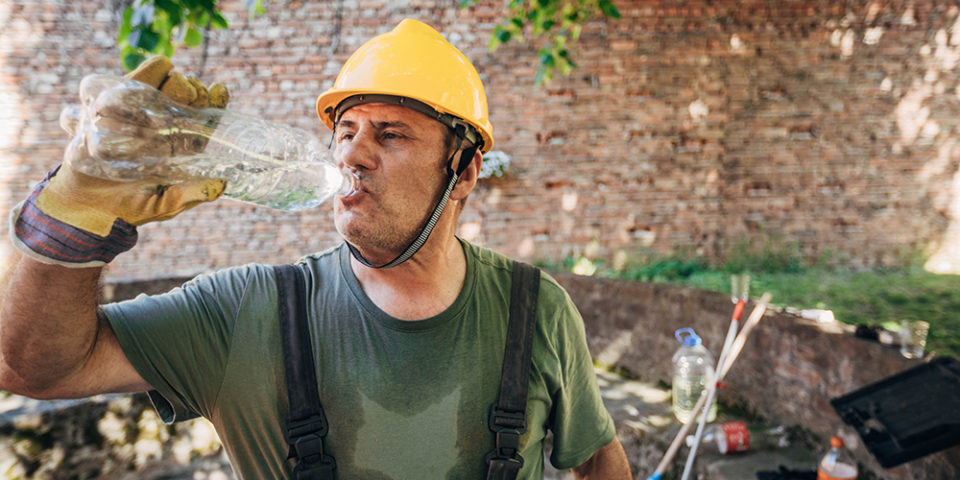5 heat-related injuries to watch for when working outside
The hot and humid summer months expose everyone to at least some level of heat. If you happen to work in a space that’s not air conditioned, continuing heat exposure can result in a range of conditions, from the simply uncomfortable to the genuinely life-threatening. Joel Smithwick, MD, explained five heat-related injuries and conditions to watch out for when the temperature climbs.
Doesn’t the human body naturally regulate heat?
“Our bodies constantly regulate heat through sweat production, water intake and thirst, muscle tone and blood flow,” said Dr. Smithwick. “These regulatory actions are pretty efficient, but they’re not invincible.”
As temperatures climb, our body’s ability to self-regulate heat starts to break down, especially when also dealing with high humidity. When employers assess heat risks in the workplace, they rely on the Wet Bulb Globe Temperature monitor, which surveys ambient temperature, radiant heat from the sun, humidity and air movement.
Aside from the temperature, sunlight and humidity factoring into our body’s ability to cool itself, health conditions such as obesity, inflammatory skin disease, dehydration, low blood pressure and cardiac diseases can limit sweat production and cooling, making the effects of heat worse.
Certain medications and other contributing factors like serious infections, advanced cancers, thyroid disease and advanced age can also increase your risk of serious heat-related injuries.
What are the most common heat-related injuries?
- Heat rash is caused by irritation and blockage of the sweat glands in your skin. Skin folds are prone to heat rash, but it can appear anywhere and often looks initially like hives. The best way to treat heat rash is to remove yourself or the affected person from heat, use topical antiperspirant and take antihistamines to relieve immediate symptoms.
- Heat cramps and muscle spams happen commonly in the legs and throughout the back. They’re caused by a loss of salts and water through sweating. Treat heat cramps by drinking water and oral electrolytes (or salts) while removing yourself or the affected person from the heat.
- Heat syncope refers to a person fainting because of the heat. It may occur after about two hours of heat exposure and is caused by loss of water through sweating and blood vessel dilation in the skin. Someone who faints as a result of overheating needs rest, cooling and rehydration.
- Heat exhaustion is caused by prolonged exposure to high heat (think 90 degrees Fahrenheit and above) without adequate salt and water intake and results in a heightened core temperature for the body. Symptoms include fatigue, thirst, nausea, headache, muscle cramps and confusion. Drink electrolyte fluid over 2–4 hours after leaving the heat, and get 24 hours of rest before attempting to work outside or in hot conditions again.
Are there any serious complications from overheating?
“Most of those examples seem fairly mild and are easily treated,” said Dr. Smithwick. “However, they shouldn’t be taken lightly. Seemingly mild initial symptoms of overheating can lead to heat stroke if untreated.”
Heat stroke is a medical emergency. It occurs when the body can no longer regulate its temperature due to overheating and loss of water and salts, forcing the core body temperature above 104 degrees Fahrenheit which puts immense strain on your system. While it’s most common in “wet bulb” ambient heat temperatures of 130 degrees Fahrenheit or higher, it can happen at lower temperatures if heavy exertion is involved.
During heat stroke, as the core temperature rises, blood pressure also initially rises and then rapidly falls. Someone might faint, have prolonged unconsciousness or even seizures. They may hyperventilate or have extremely hot, dry skin. Extreme body heat from heat stroke can damage vital organs, and most strongly affects the brain, heart, liver and kidneys.
Someone with heat stroke should immediately be removed from heat. Remove unnecessary clothing and use cool water and high-flow cool air via vans to encourage the body to cool down. Having the person sit in cold or iced water can help, but it should be stopped as soon as the person’s body temperature starts to go back down below 102 degrees Fahrenheit.
A person with heat stroke should receive emergency medical care and may need transferred to a medical ICU, or intensive care unit, for immediate treatment. More than 4,000 cases of heat stroke occur in the USA each year, and some result in very serious injury or even death.
How can I prevent heat-related injuries?
“Fortunately, heat injury is very preventable if you take note of your personal risks and make changes accordingly,” said Dr. Smithwick.
You can find some tips on how to stay safe in the heat here on Flourish, but a few other pieces of advice include:
- Monitor the temperature outside and consider whether ambient temperatures might be even higher due to reflected sunlight, pavement or other environmental concerns.
- Limit your time working in the heat and take plenty of breaks to head somewhere cooler
- Hydrate properly and keep track of how much water you’ve had to drink. Consider electrolyte-replacement drinks to help deal with the loss of salts through sweat.
- Practice safe acclimatization to the heat to help your body adapt.
What is acclimatization?
“Acclimatization prevents heat-related injuries by helping the body learn how to cool itself in higher temperatures,” said Dr. Smithwick. “It can be very helpful to those who primarily work outside to prevent injury and make it easier for them to get through the workday.”
For new workers, there should be no more than 20% exposure for the first day (think two hours out of a 10-hour day), with an increase of no more than 20% more exposure time each additional day. For more experienced workers, start with 50% exposure, and add ten percent more each day.
You deserve a safe and healthy workplace
We help employers improve the health and wellness of their workforce by offering a variety of services that can be tailored to meet their needs.
Learn More

